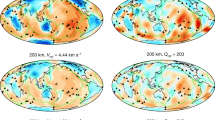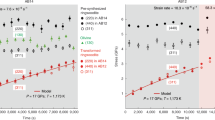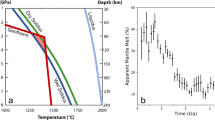Abstract
The seismic low-velocity zone has been thought to correspond to a zone of partial melting that significantly reduces the creep strength, making it possible for the plates to decouple from the underlying mantle1,2. This view is examined here in light of recent experimental results which show that water has more effect on the creep strength of olivine3–6 than does partial melting7,8 and that the former depends on the fugacity of water5,6. When there is a limited amount of water, partial melting will result in depletion of water from olivine, and therefore have a hardening, rather than a softening, effect.
This is a preview of subscription content, access via your institution
Access options
Subscribe to this journal
Receive 51 print issues and online access
$199.00 per year
only $3.90 per issue
Buy this article
- Purchase on Springer Link
- Instant access to full article PDF
Prices may be subject to local taxes which are calculated during checkout
Similar content being viewed by others
References
Ringwood, A. E., in The Earth's Crust and Upper Mantle (ed. Hart, P. J.) 1–17 (American Geophysics Union, Washington DC, 1969).
Anderson, D. L. & Sammis, C. Phys. Earth planet. Inter. 3, 41–50 (1970).
Chopra, P. N. & Paterson, M. S. Tectonophysics 78, 453–473 (1981).
Chopra, P. N. & Paterson, M. S. J. geophys. Res. 89, 7861–7876 (1984).
Karato, S., Paterson, M. S. & FitzGerald, J. D. J. geophys. Res. (in the press).
Mackwell, S. J., Kohlstedt, D. L. & Paterson, M. S. J. geophys. Res. (in the press).
Cooper, R. F. & Kohlstedt, D. L. Tectonophysics 107, 207–233 (1984).
Chopra, P. N. & Kohlstedt, D. L. EOS 64, 323 (1983).
Burnham, C. W. in The Evolution of the Igneous Rocks (ed. Yoder, H. S. Jr) 439–482 (Princeton University Press, 1979).
Hobbs, B. E. J. geophys. Res. 89, 4026–4038 (1984).
Ito, E., Harris, D. M. & Anderson, A. T. Jr Geochim. cosmochim. Acta 47, 1613–1624 (1983).
Moore, J. G. Contr. Miner. Petrol. 28, 272–279 (1970).
Ringwood, A. E. Composition and Petrology of the Earth's Mantle (McGraw-Hill, New York, 1975).
Shankland, T. J., O'Connell, R. J. & Waff, H. S. Rev. Geophys. Space Phys. 29,394–406 (1981).
Toramaru, A. & Fujii, N. J. geophys. Res. (submitted).
Goetze, C. in High Pressure Research, Application in Geophysics (eds Manghnani, M. H. & Akimoto, S.) 3–23 (Academic, New York, 1977).
Karato, S. Tectonophysics 104, 155–176 (1984).
van der Molen, I. & Paterson, M. S. Contr. Miner. Petrol. 70, 299–318 (1979).
Author information
Authors and Affiliations
Rights and permissions
About this article
Cite this article
Karato, S. Does partial melting reduce the creep strength of the upper mantle?. Nature 319, 309–310 (1986). https://doi.org/10.1038/319309a0
Received:
Accepted:
Issue Date:
DOI: https://doi.org/10.1038/319309a0
This article is cited by
-
Generation and evolution of the oceanic lithosphere in the North Atlantic
La Rivista del Nuovo Cimento (2022)
-
Water in the Earth’s Interior: Distribution and Origin
Space Science Reviews (2017)
-
Upper-mantle water stratification inferred from observations of the 2012 Indian Ocean earthquake
Nature (2016)
-
Numerical models of convection in a rheologically stratified oceanic upper mantle: Early results
Earth, Planets and Space (2014)
-
Long-Term Evolution of the Martian Crust-Mantle System
Space Science Reviews (2013)
Comments
By submitting a comment you agree to abide by our Terms and Community Guidelines. If you find something abusive or that does not comply with our terms or guidelines please flag it as inappropriate.



